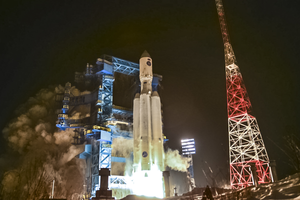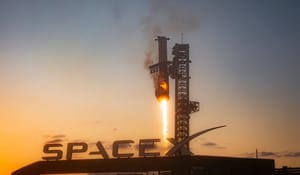
Apr 10, 2024
Angara's Past, Present, and Future: A Chronicle of Aspirations and Uncertainties
The Soviet Space Program while "losing its dominance" after the space race remained a strong space power on par with NASA capabilities in many respects. Yet after the collapse of the Soviet Union there was a huge issue with the distribution of Soviet assets which led to lengthy cooperation that halted what was now Roscosmos.
The Russian led space program still relied on diplomacy to maintain many launch vehicles and to maintain their main launch site In Kazakhstan. The Russians then as a response to this set the course toward the development of a new launch vehicle, whose design and launch facilities would not rely on contractors outside Russia. This was a bold plan to bring back Russian dominance in space and reclaim the legacy of the Soviet program.
The Proton
Having its origins from the beginning of the Space Race like most Russian spacecrafts and launchers the proton was a heavy lift launcher meant to support the L1 program. The L1 program aimed to send two cosmonauts on a circumlunar trajectory on the moon to verify and establish key technologies for the lunar landing program (L3).
By the end of the 1990s, after the disillusion of the Soviet Union, Russian aerospace engineers worked on modernizing the Proton rocket with new algorithms, new construction methods, increased accuracy and so on. The Proton however had varying levels of success in the actual commercial market with the rise of Arianespace.

Russia was not only utilizing decades old launch vehicle designs but these launch vehicle designs failed to stay competitive or reliable.
Development of Angara
The design of the Angara would use heritage technology from the most advanced aspects of the soviet space program, Energia and Zenit. The four chambered RD-170 essentially was diminished to a singular chamber. Angara also utilized the much more modern fuel that is Kerolox as opposed to the hypergolics used by Proton. Proton has had to deal with a myriad of critiques both political and technical wise about its use of toxic hypergolic propellants, that toxicity is not prevalent in Kerolox rockets.
Angara's main engine also has the benefit of being a relatively matured design with tons of flight time with various engines that it shares considerable heritage with. These engines include the RD-180 on the Atlas V, the RD-171 on the Zenit, The RD-170 on Energia, and extensive static fires verifying the high throttle capabilities of the engine. The main engine is also considerably efficient due to it being a closed cycle engine.

Angara was designed at first to be merely a proton replacement but it evolved into a plan for a highly modular domestic rocket program that would use shared architecture across a myriad of Angara vehicles for commonality. Yet the core of the Angara rocket was the idea of a fully domestic rocket, with designs in Russia, components made in Russia, engines made in Russia, launch from Russia etc.
Angara was set to be a highly adaptable vehicle from Angara 1, a small launch vehicle, to Angara 100, a SHLV. Plans were even laid out for flyback versions of the common core design designated Baikal, after a Siberian lake. These boosters would utilize wings and aerodynamic surfaces to land similar to that of a plane to be refurbished and re-flown to decrease costs.

After finishing the infrastructure and development of many key aspects of Angara, they started with a suborbital testflight to verify the universal core module. The second flight was a real configuration, the Angara 5, that carried a test object into a geostationary orbit that then shifted into a graveyard orbit. It then carried another mass simulator testing the same configuration. This same configuration flew again carrying another mass simulator.
These are all spaced out over several years, as Russia could not get any buyers their latest flagship rocket has long resorted to dummy payloads. Two operational satellites were launched in 2022 by Angara and operated by Roscosmos.
The April 2024 launch set to be from Vostochny Cosmosdrome is a verification of the new launch site more then anything and again has no real payload. Angara is currently set for another launch later this year, a communications satellite in 2025, and then aid in the assembly of Russia's new orbital service station. With the rapid decline of Roscosmos and the many failures plaguing its program and failure to evolve from Soviet era technology after decades many question Russia's ability to maintain a dominant space power.
Concluding Thoughts
It becomes evidently clear after looking at Angara's tragic history that this was a rocket born from aspirational goals to reclaim a legacy that appears to be long gone. After Russia's recent invasion of Ukraine, Russia continues to face inreasing issues with securing collaboration with other space programs. Russia's biggest ally in Space is China currently. While Russia claims lofty goals little progress has been seen on not only their ambitious future claims but the very basis of their only fully domestic rocket program.
In the solemn annals of space exploration, Angara stands as a poignant symbol of aspirations unfulfilled and promises left drifting in the void. Conceived from the remnants of the once-mighty Soviet space program, it was envisioned as a beacon of Russian innovation and resurgence, a testament to a nation's enduring legacy in the cosmos. Yet, as the pages of time turn, Angara's trajectory has veered tragically off course, failing to ascend to the lofty heights it was destined for.
In its inception, Angara held the promise of a new era in Russian space dominance, with its sleek design and ambitious modular architecture. It was heralded as the harbinger of a fully domestic rocket program, a manifestation of Russian prowess from conception to launch. However, reality has proven to be a harsh adversary, as Angara's journey has been fraught with setbacks and disappointments.
The initial test flights, once filled with anticipation, now serve as haunting reminders of unmet expectations. Dummy payloads replace the envisioned satellites, and the once-heralded launch sites stand as silent witnesses to missions that never materialize. With each passing year, Angara's narrative becomes more somber, its once-bright future dimming against the backdrop of geopolitical turmoil and technological stagnation.



